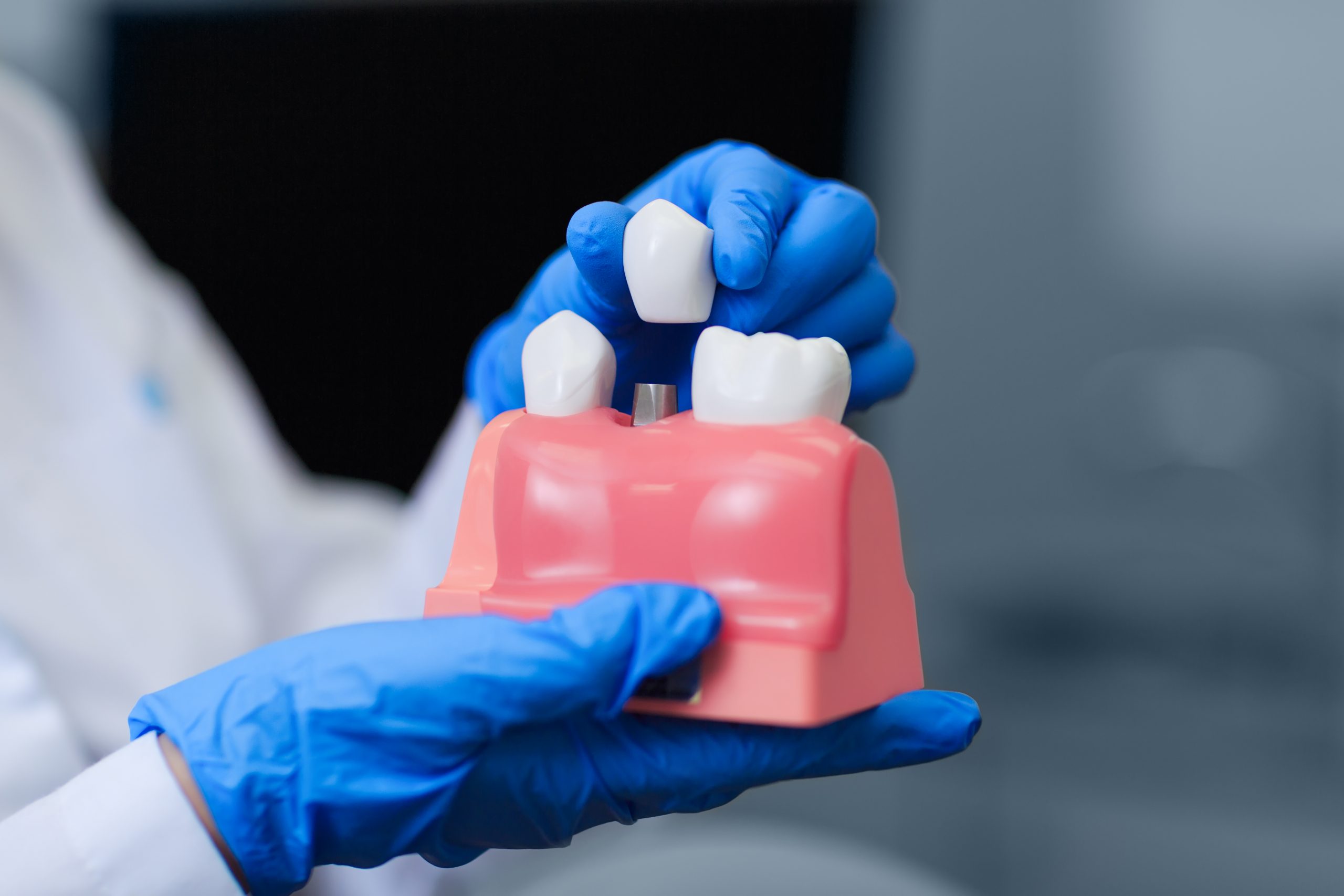Implant Placement Leads to Appendectomy and Colonoscopy
Case Study
Marc Leffler, DDS, Esq.
September 13, 2022
Reading time: 7 minutes

Background Facts
A 73-year-old man, whose medical history consisted of diabetes and hypertension, both well-controlled with medication, diet, and weight management presented to an oral surgeon on referral from the patient’s general dentist. Mr. J had been edentulous in the posterior lower left quadrant for a number of years, with the distal-most tooth in that area being #20; otherwise, he had an essentially complete dentition in good repair. At the consultation visit with the OMS, a CBCT was taken in conjunction with a clinical examination: there was adequate buccolingual width of the mandible and approximately 15mm of available bone superior to the inferior alveolar canal. Dr. N explained the entirety of the implant procedure, to be performed with local anesthesia, and involving the placement of two 11mm endosseous implants, which would ultimately be restored by the referring dentist. A thorough back-and-forth discussion about risks, benefits and alternatives took place, with Mr. J signing an “implant consent form” that day. Surgery was planned for the following week.
On the day of surgery, Mr. J came to the office alone, ready to proceed. Dr. N again asked if her patient had any further questions before injecting local anesthesia, but he did not. After the patient became anesthetized, Dr. N performed the implant osteotomies as she had done so many times before, with a dental assistant employing a high-speed suction and retracting the tongue toward the right side of the mouth. Nearing the end of the procedure, Dr. N lost control of the implant driver she was using when Mr. J coughed without warning. She last saw the driver at the back of the tongue, before losing sight of it. Unsure of where it had gone, she closed the surgical site and instructed Mr. J to immediately go to a free-standing medical clinic in close proximity to the OMS’s office, which Dr. N called to alert the physician as to what had happened.
There, the physician ordered radiographs, which revealed that the driver had made its way into the stomach. With the patient in no distress, the physician advised Mr. J that the driver would very likely pass in his stool within a few days without any intervention; however, if it did not pass within 4 days, or if he began to have any abdominal pain or other symptoms, Mr. J should return or seek hospital care immediately. Mr. J did, in fact, begin to have lower right abdominal discomfort on the third post-procedure day, in conjunction with the lack of a bowel movement since the prior day and a total lack of appetite, so his friend drove him to a local hospital emergency department.
At the ED, a CT scan was promptly performed, showing that the driver was located in the appendix. Mr. J was told that he would need an appendectomy, and a surgeon was called. Because the surgeon had 2 scheduled procedures for the day, the first of which was then ongoing, he was not able to attend to Mr. J for more than 4 hours. Later that afternoon, Mr. J was in the operating room, having a laparoscopic appendectomy under general anesthesia. Upon removal of the appendix, the driver was not located in it. When Mr. J arrived in PACU, abdominal flat films were ordered and performed.
The driver had, between the time of the CT and surgery, made its way out of the appendix and was radiographically found in the hepatic flexure of the colon. The following morning, a gastroenterologist performed a colonoscopy, locating and removing the driver. Mr. J remained in the hospital for another night, receiving IV fluids and medications. He was then discharged and followed an uncomplicated course to recovery.
Legal Action
In less than a month, Dr. N received a letter from Mr. J’s attorney, requesting a complete copy of her records for this patient; she complied with the request and immediately contacted her malpractice insurer. The attorney then assigned to the case by the carrier immediately reached out to Mr. J’s attorney, who forwarded on all of the medical records. When Dr. N and her new attorney met, they reviewed all of the records together.
Dr. N acknowledged the events that took place during the implant procedure, expressed how badly she felt about all that happened, which she believed was her fault, and told her attorney that she wished to try to resolve things with Mr. J as soon as possible.
The 2 attorneys spoke, with Mr. J’s counsel saying that his client would be willing to resolve the situation if he was reimbursed for all of the medical expenses for which he was responsible and for unrecoverable costs for a scheduled vacation which had to be cancelled, as well as an amount for emotional distress and the pain which followed the appendectomy, which limited his activity for some time. With the approval of the insurance carrier, after a review from an expert, the case was settled prior to a lawsuit having been filed.
Takeaways
It is not uncommon for foreign objects to be swallowed or aspirated during the course of dental treatment, either because of a patient’s sudden move, or a simple loss of grip of a wet instrument, or an errant piece of a tooth in the process of sectioning for removal. For some dental procedures, a rubber dam can be applied, and it creates the best shield against such events; in other situations, a piece of dental floss can be tied to small instruments so that, even if grip is lost, the instrument can be retrieved by simply pulling on the floss; in still other situations, placing a protective gauze drape behind the treatment field can help to “catch” a foreign object; and an attentive dental assistant with suction always serves as the final back-up measure. Whatever methods are used, standard of care dictates that it is the surgeon’s obligation to protect the patient from foreign objects being swallowed or aspirated.
The series of events within the intestinal tract here might seem odd and unlikely, with the general legal principle that practitioners are potentially liable for only the foreseeable consequences which result from negligent acts. While it can be argued that it was not specifically foreseeable that the driver would have made its way into the appendix in the first place, and then back out again, it was certainly generally foreseeable that a swallowed driver would end up in the colon and potentially cause damage to the patient and/or the need for interventional treatment, so that would fulfill the legal requirement.
Once again on the issue of foreseeability, but here in the context of informed consent, patients must be advised of foreseeable risks, as well as benefits and alternatives. The fact that most consent discussions and most consent forms do not include the potential for swallowing and/or aspiration of a foreign body may again serve as an argument that liability should not lie when such an event happens. But that argument is not legally sound because informed consent protects practitioners from risks which occur in the absence of negligence, not because of negligence; patients cannot “sign away” the right to have treatment performed upon them in a non-negligent fashion. (In contrast, for example, is the risk of a patient suffering an inferior alveolar nerve injury from the extraction of a tooth which has roots in direct proximity to that nerve, such that, no matter how ideally the extraction was performed, that injury might well be expected to result.) Some untoward events cannot be protected against, but some can, and a swallowing/aspiration event is among the latter.
If this case were to have proceeded beyond where it did, a defense strategy might have included that the ED physician should have asked a gastroenterologist to perform an endoscopy – which, if successful, would have spared the need for the subsequent treatment – or that the abdominal surgeon should have first ordered a further CT study to assure that the driver was still in the appendix, before performing surgery, given the time that had passed. If, during litigation (had the case not settled pre-suit), the ED physician and/or the abdominal surgeon were co-defendants of the oral surgeon, they might be found partially liable and would be obligated to pay (or have paid on their behalf) their determined percentage portion of liability, but if the oral surgeon were the sole defendant, then many, if not most, jurisdictions would levy full liability against that oral surgeon under the theory that the initial wrongdoer is liable for the results of all actions which reasonably follow, even if some or all of those actions were negligent. [We point out here that States vary widely on this concept, so the general model presented here may vary significantly in particular situations.]
Finally, an OMS’s agreement or desire to settle may come at any step in the entire process, from the time an attorney’s letter is first received, to the moment before a jury enters the courtroom to render its verdict. It is a very personal decision, based upon very personal factors, and it is best made in conjunction with the attorneys representing them and the insurer indemnifying them.
Note that this case presentation includes circumstances from several different closed cases, in order to demonstrate certain legal and risk management principles, and that identifying facts and personal characteristics were modified to protect identities. The content within is not the original work of MedPro Group but has been published with consent of the author. Nothing contained in this article should be construed as legal, medical, or dental advice. Because the facts applicable to your situation may vary, or the laws applicable in your jurisdiction may differ, please contact your personal or business attorney or other professional advisors if you have any questions related to your legal or medical obligations or rights, state or federal laws, contract interpretation, or other legal questions.
Additional Risk Tips content

OMS Relents After Patient on Blood Thinners Demands Tooth Extraction
A real-life case study exploring the ethical and clinical challenges faced by an oral surgeon when a patient on anticoagulant therapy demanded an emergency tooth extraction. Learn how patient autonomy, standard of care, and legal implications intersect in high-risk scenarios.

Proactive Strategies to Avoid OMS Malpractice Claims
Patient care is complex and personal, which is why it can lead to malpractice risk for oral and maxillofacial surgeons...

Patient Must Cancel Joint Surgery Due to New Dental Guidelines
Read about a patient who faces unexpected consequences when their oral surgeon is not up-to-date on new dental guidelines.
This document does not constitute legal or medical advice and should not be construed as rules or establishing a standard of care. Because the facts applicable to your situation may vary, or the laws applicable in your jurisdiction may differ, please contact your attorney or other professional advisors if you have any questions related to your legal or medical obligations or rights, state or federal laws, contract interpretation, or other legal questions.
MedPro Group is the marketing name used to refer to the insurance operations of The Medical Protective Company, Princeton Insurance Company, PLICO, Inc. and MedPro RRG Risk Retention Group. All insurance products are underwritten and administered by these and other Berkshire Hathaway affiliates, including National Fire & Marine Insurance Company. Product availability is based upon business and/or regulatory approval and/or may differ among companies.
© MedPro Group Inc. All rights reserved.